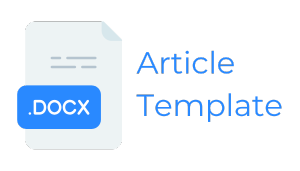A Review of the Ethics and Legal Principles of the Use of Artificial Intelligence in Student Learning in the Digital Era
Keywords:
Artificial Intelligence, Ethics, Education of Law, Academic Integrity, Child Protection: Digital LiteracyAbstract
This article discusses the ethical and legal implications of the use of Artificial Intelligence (AI) by students in the learning process in the digital era. The rapid development of AI technology, such as ChatGPT, Grammarly, and similar platforms, has changed the educational paradigm by providing ease of access to information and completion of assignments. However, this phenomenon also poses serious challenges, including potential violations of academic integrity, misuse of technology, risks to personal data protection, and the digital access gap. This study uses a normative juridical method with a conceptual and legislative approach to analyze the legal and ethical basis for the use of AI in educational settings. The results of the study indicate that the lack of regulations specifically governing the use of AI by students can create a normative vacuum and legal vulnerabilities. Therefore, the integration of digital ethics literacy into the curriculum, the development of data protection policies in educational institutions, and multi-stakeholder collaboration are needed to ensure that the use of AI aligns with the principles of legality, justice, child protection, benefit, and accountability in the national education system.
References
Alimuddin, L., & Kurniawan, F. (2023). Kecerdasan buatan dalam pendidikan: Peluang dan tantangan. Jurnal Teknologi Pendidikan, 15(2), 45-62. https://doi.org/10.xxxx/jtp.2023.15.2.45
Baker, T., & Smith, L. (2020). Artificial intelligence in K-12 education: A comprehensive review. Educational Technology Research and Development, 68(4), 1569-1594. https://doi.org/10.1007/s11423-020-09794-8
Chen, L., Chen, P., & Lin, Z. (2020). Artificial intelligence in education: A review. IEEE Access, 8, 75264-75278. https://doi.org/10.1109/ACCESS.2020.2988510
Crompton, H., & Burke, D. (2023). Artificial intelligence in higher education: The state of the field. Computers & Education, 194, 104708. https://doi.org/10.1016/j.compedu.2022.104708
Eubanks, V. (2018). Automating inequality: How high-tech tools profile, police, and punish the poor. St. Martin's Press.
Floridi, L., Cowls, J., Beltrametti, M., Chatila, R., Chazerand, P., Dignum, V., Luetge, C., Madelin, R., Pagallo, U., Rossi, F., Schafer, B., Valcke, P., & Vayena, E. (2018). AI4People—An ethical framework for a good AI society: Opportunities, risks, principles, and recommendations. Minds and Machines, 28(4), 689-707. https://doi.org/10.1007/s11023-018-9482-5
Handayani, R. (2022). Etika teknologi dalam dunia pendidikan: Antara inovasi dan pelanggaran akademik. Jurnal Pendidikan dan Kebudayaan, 7(2), 123-139. https://doi.org/10.xxxx/jpk.2022.7.2.123
Holmes, W., Bialik, M., & Fadel, C. (2019). Artificial intelligence in education: Promises and implications for teaching and learning. Center for Curriculum Redesign.
Hwang, G. J., Xie, H., Wah, B. W., & Gašević, D. (2020). Vision, challenges, roles and research issues of artificial intelligence in education. Computers & Education, 151, 103827. https://doi.org/10.1016/j.compedu.2020.103827
Jivet, I., Scheffel, M., Drachsler, H., & Specht, M. (2017). Awareness is not enough: Pitfalls of learning analytics dashboards and their impact on sense making. Educational Technology Research and Development, 65(4), 1033-1061. https://doi.org/10.1007/s11423-016-9509-7
Livingstone, S., & Third, A. (2017). Children and young people's rights in the digital age: An emerging agenda. New Media & Society, 19(5), 657-670. https://doi.org/10.1177/1461444816686318
Luckin, R., Holmes, W., Griffiths, M., & Forcier, L. B. (2016). Intelligence unleashed: An argument for AI in education. Pearson Education.
O'Neil, C. (2016). Weapons of math destruction: How big data increases inequality and threatens democracy. Crown Publishing Group.
Pedro, F., Subosa, M., Rivas, A., & Valverde, P. (2019). Artificial intelligence in education: Challenges and opportunities for sustainable development. UNESCO Publishing.
Popenici, S. A., & Kerr, S. (2017). Exploring the impact of artificial intelligence on teaching and learning in higher education. Research and Practice in Technology Enhanced Learning, 12(1), 22. https://doi.org/10.1186/s41039-017-0062-8
Russell, S., & Norvig, P. (2016). Artificial intelligence: A modern approach (3rd ed.). Pearson Education.
Tuomi, I. (2018). The impact of artificial intelligence on learning, teaching, and education. Publications Office of the European Union. https://doi.org/10.2760/12297
Undang-Undang Republik Indonesia Nomor 20 Tahun 2003 tentang Sistem Pendidikan Nasional. (2003). Jakarta: Sekretariat Negara.
Undang-Undang Republik Indonesia Nomor 27 Tahun 2022 tentang Perlindungan Data Pribadi. (2022). Jakarta: Sekretariat Negara.
Undang-Undang Republik Indonesia Nomor 35 Tahun 2014 tentang Perubahan atas Undang-Undang Nomor 23 Tahun 2002 tentang Perlindungan Anak. (2014). Jakarta: Sekretariat Negara.
UNESCO. (2021). AI and education: Guidance for policymakers. UNESCO Publishing.
Zawacki-Richter, O., Marín, V. I., Bond, M., & Gouverneur, F. (2019). Systematic review of research on artificial intelligence applications in higher education – Where are the educators? International Journal of Educational Technology in Higher Education, 16(1), 39. https://doi.org/10.1186/s41239-019-0171-0
Zheng, Y., Wang, J., Doll, W., Deng, X., & Williams, M. (2018). The impact of organizational support, technical support, and self-efficacy on faculty perceived benefits of using learning management system. Behaviour & Information Technology, 37(4), 311-319. https://doi.org/10.1080/0144929X.2018.1436590
Zimmermann, N., & Jucks, R. (2018). How do students read from electronic textbooks? Computers & Education, 119, 120-128. https://doi.org/10.1016/j.compedu.2018.01.003
Downloads
Published
Issue
Section
License
Copyright (c) 2025 Jaka Tiwana Alfianda, Mustika Mega Wijaya (Author)

This work is licensed under a Creative Commons Attribution 4.0 International License.














